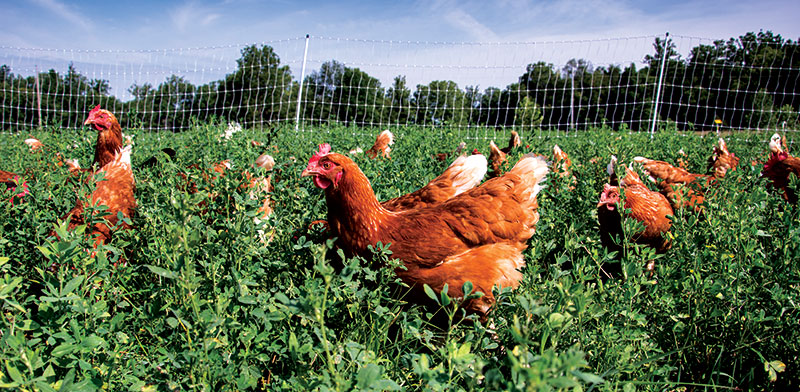
Do you keep creatures in? Or do you keep creatures out? That is the ultimate question of livestock fencing. The answer lies in just about any gauge metal or plastic wire or electrified, old-fashioned, moveable or stationary fencing.
We’re a lucky bunch of chicken keepers, to keep birds in an age of technology where just about anything is available at our fingertips. Let’s explore three of the available styles and technologies of livestock fencing and how well they work for our flocks.
Why Do You Need It?
Before spending a bundle on, well, a bundle of fencing, ask yourself why you need the material. Will you use it to rotate pastures for chickens to graze during the day? Will it keep all manner of predators out of the coop? Will it be for a brooder, protecting very small and vulnerable chicks?
Generally speaking, the higher the vulnerability of the inhabitants—such as chicks—the heavier duty the fencing should be. On the other end of the spectrum, say, for daytime grazing with the watchful eye of a guardian nearby, flocks might need significantly less.
Birds on a Wire
While chicken wire might seem perfect, it’s not a multi-purpose fencing material. Chicken wire of the right height will do a fair job of keeping full-grown chickens confined to an area; most domestic layers will respect the boundary. Some game birds prone to flight, however, might attempt to go over, and the tiniest of the young chicks might attempt to go through—and make it.
Herein lies one of the fatal flaws of chicken wire: It’s flimsy, and the openings are too large. Chicken-wire openings are about 11⁄2 inches across. When you consider that certain predators, such as weasels, rodents or snakes, can fit through an opening about 1 inch in diameter, you can see the dilemma. The material itself is also rather thin and flimsy: Larger predators, such as bears, could easily crush it. More cunning predators, such as raccoons, can easily fit an arm through and pull a chicken leg, wing or head through the opening.
But chicken wire does have its place. It makes a wonderful option for lightweight jobs, such as covering an indoor brooder for keeping chicks contained, separating birds within a more secure coop (pictured on page 20) or keeping birds out of your garden.
Electric Company
Electric net fencing is usually made of a plastic, semi-rigid material that conducts an electrical charge but also resists sagging. Much of the electric fencing available today is operated by small solar panels sold with the units. When turned off, the fencing is easy to gather up and move.
Electric poultry netting is a favorite with chicken keepers who rotate their flocks among grazing pastures because of that portability. It also helps protect a ranging flock from daytime land predators. For some backyard chicken-keepers with the space to spare, this can be a wonderful tool to give more confined flocks some grazing area without sacrificing large parts of the yard at any one time.
Electric fencing is affordable, but it isn’t cheap. Remember that this type of material is also not appropriate for lining the coop or windows, and it’s never a replacement for locking up the flock in a secure coop each night at dusk.
Covered in Cloth
Hardware cloth is the name given to a very rigid type of wire mesh material. Unlike chicken wire, hardware cloth has mesh openings of a very small size and is available in a range of thicknesses. It’s available in several finishes as well; the wire might be welded-before-wired, wired-before-welded or vinyl coated. Each of these options has a different price and purpose.
Vinyl-coated hardware cloth is best in situations where birds will spend time with their feet in direct contact with the wire, as the vinyl softens the wire and reduces the risk of injury. That said, it’s always best that chickens spend most of their lives on solid ground and natural earth, minus the time spent in the coop, which would ideally have a layer of bedding lining the floor.
The other forms of hardware cloth are ideal for securing windows, doors and gaps in the coop. Hardware cloth is as impenetrable as fencing materials get—when it comes to chickens and their predators, anyway. It’s the ideal choice for lining outdoor runs to keep predators out and keep chickens in.
For an added level of security against digging predators, line the perimeter of the coop and/or run with a buried layer of hardware cloth.
Predator-Proofing Tips
Remember these measures and stay ahead of the predators, large and small.
- Close any gaps larger than 1 inch in diameter in the coop, tractor or run.
- Securely close and lock the coop door each night at dusk or when your chickens head to bed.
- Bury wire material around the coop or run, dig a trench approximately
1 foot deep and 1 foot wide around the perimeter of the structure. After securely attaching the wire to the structure, lay it out in the trench, either straight down or in an L-shape. Bury the fencing fully until you reach ground level once again. Monitor for digging activity on a regular basis. - Collect eggs daily (multiple times a day, if possible), reducing the temptation for certain predators, such as snakes.
- So as to not attract rodents—and therefore snakes—clean up all treats, kitchen scraps and old food as soon as the chickens are finished.
- Securely lock food in an airtight storage container.
Many of us keep chickens in an effort to reduce our commercial consumption, eat closer to home and/or save money. When it’s the latter, we might be tempted to skimp in certain areas. I advise you to consider fencing, and its related coop security, an absolute financial priority.
I’ve known too many new chicken keepers who went against this advice and lost entire flocks to predators. Rest assured: It can happen to you anywhere you keep chickens. Consider the loss of an entire flock, monetarily and emotionally, a greater one than the commitment to good fencing. As always, an ounce of prevention—or, in this case, portable electric fencing and hardware cloth—is worth a pound of cure.
This story originally appeared in the November/December 2017 issue of Chickens magazine.




